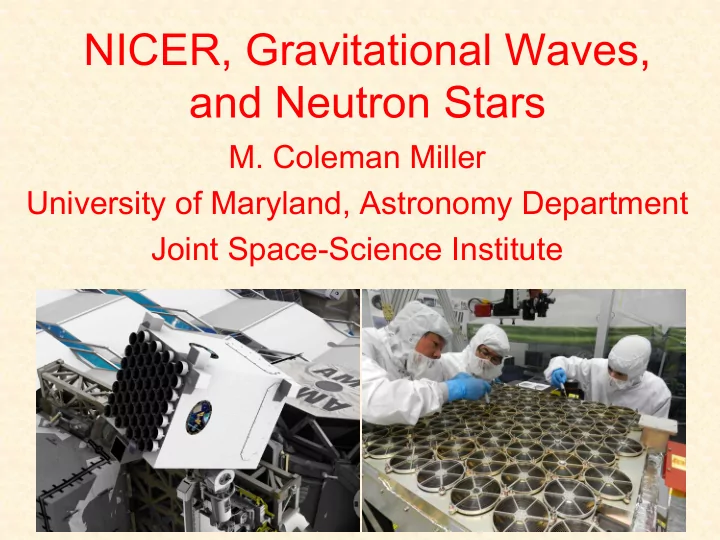

NICER, Gravitational Waves, and Neutron Stars M. Coleman Miller University of Maryland, Astronomy Department Joint Space-Science Institute
Outline • The importance of neutron star radii • NICER measurements of mass and radius of PSR J0030+0451 Will talk only about our work (Miller, Lamb, Dittmann+ 2019) Please also read other papers in the ApJ Letters focus issue, especially Riley et al. 2019; Raaijmakers et al. 2019; Bilous et al. 2019 Key point: favored models from the two NICER groups are fully consistent with each other in M, R, and spot patterns
Questions During Talk • Please feel free to ask questions at any time • I will also pause twice during the talk to determine whether anyone would like to pursue discussion points
But First: The Main Results • For the 205.53 Hz pulsar PSR J0030+0451 Isolated pulsar: no indep knowledge of M • Equatorial radius • Gravitational mass • Best configuration has three spots; almost equally good configuration has two spots • All spots are in the rotational hemisphere opposite observer. At least one spot is highly elongated
The Importance of Radii • Radius would provide great EOS leverage Wide range in models • But tough to measure • Previous published measurements are susceptible to huge systematic error • NICER X-ray pulse modeling can help Demorest+ 2010
The Importance of Radii • Radius would provide great EOS leverage Wide range in models • But tough to measure • Previous published measurements are susceptible to huge systematic error • NICER X-ray pulse modeling can help Demorest+ 2010
Radius Bias with T Variation Example of the bias toward low radii from single-temp fits to surface with varying temperature. Temperature varies smoothly from 2 keV (equator) to 0.2 keV (pole). Fit is good, but R is 13% low. With narrower T profile, correction is larger Good fit and lack of pulsations does not guarantee uniformity! Assume perfect energy response, zero N H
Key: Minimal Systematic Errors • Extensive work by Fred Lamb (Illinois) and myself with our collaborators suggests that when we fit energy-dependent waveforms, systematic errors are minimized • We have generated synthetic data using models with different beaming, spectra, spot shapes, temperature distributions etc. than used in fitting the data • Conclusion: if good fit, no significant bias
The Idea in Brief Bayesian fits: trace rays from hot spots on NS surface, compare with energy-dep waveform
Concern about rotation? • Fundamentally, we are tracing photons from the star to the observer • If star is not rotating, this is relatively simple: no rotation means spherical symmetry, so a given photon travels in a plane • Not true when there is rotation; frame- dragging. • Also, star becomes oblate
Frame-dragging doesn’t matter 9 Approximations: Bogdanov et al. 2019 8 S+D: star is spherical, n =200 Hz f E (10 -4 cm -2 s -1 keV -1 ) 7 Schwarzschild+SR ray 6 tracing. 5 OS: star is oblate, 4 Numerical S+D Schwarzschild+SR ray OS 1.5 3 S+D Difference OS Difference tracing. Shape Difference Numerical Error 1 Fractional diff. (%) Compare with full 0.5 numerical waveform 0 Conclusion: to the -0.5 0 0.1 0.2 0.3 0.4 0.5 0.6 0.7 0.8 0.9 1 Rotational Phase precision we need, we Figure by Sharon Morsink based on original can treat spacetime as concept by Scott Lawrence (UMd) if there is no rotation
Effect of Rotation on M-R Curves M vs. R for four EOS, at 200 Hz vs. 0 Hz. Difference is negligible compared with measurement precision. Calculations by Sharon Morsink.
Models Used in Fits • We consider uniform-temperature spots Possibly different T; arbitrary locations • Each spot can be oval: start with a circular spot and stretch or squash it azimuthally Fits include unmodulated background • Fits use two or three oval spots Arbitrary overlap of spots Gives great flexibility of modeling (e.g., can have isolated spots, or crescents)
Fit to Synthetic Two-oval Data Inner contour: 68% of posterior probability Outer contour: 95% of posterior probability
Any Questions At This Stage?
Mass-Radius Posteriors for J0030 Left: M-R posterior for NICER J0030 data, two ovals Right: M-R posterior for NICER J0030 data, three ovals
1D Posteriors: NICER 2,3-oval Gaussian prior on distance: ; chan 40-299 Top: analysis of NICER data, two-oval model Bottom: analysis of NICER data, three-oval model Dotted line on right: distance prior
Bolometric Waveforms Left: two-oval model fits to NICER J0030 data Right: three-oval model fits to NICER J0030 data Dotted lines are individual spots; solid, total
Bolometric Residuals Residuals of best-fit three-oval model compared with J0030 NICER data, for 64 phases. Fit is good
Phase-Channel Residuals Residuals (in c ) for best three-oval fit to NICER J0030 data. No patterns are evident, as one would expect from a good fit ( c 2 /dof=8189/8040, 12%)
Spot Patterns Top: two-oval fit. Bottom: three-oval fit Horizontal solid line shows observer inclination
Shouldn’t B be a centered dipole? Credit: NASA • Uranus’ and Neptune’s fields aren’t! • Millisecond pulsars go through complex evolution; B, spots need not be simple
Any Questions?
NICER Contribution to EOS Red line: ratio of the 5%-95% pressure range when NICER (M,R) from J0030 is included, to the range prior to NICER, as a function of density NICER M and R reduces pressure range by 10-30% from ~ r sat to 2 r sat Exposure time will ~double by end of 2020. Can incorporate into full EOS constraints: Miller, Chirenti, Lamb 2020, many other papers
Implications for Equation of State Dashed lines: Hebeler+ EOS Top: spectral EOS. Bottom: piecewise polytrope Left: prior (dot-dash 0%-100%; solid 5%-95%) Middle: result of adding NICER M-R for J0030; 5%-95% Right: result of also adding high-M and L upper limit
Conclusions • First NICER measurements, for PSR J0030+0451, have already tightened EOS constraints. Full, (M,R) posterior samples: https://zenodo.org/record/3473466 • Key: measurements appear reliable as well as precise • Doubling+ of data set and contributions from analysis of other pulsars (especially J0437 [best precision] and J0740 [highest mass]) will improve constraints substantially
Recommend
More recommend